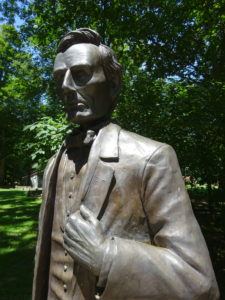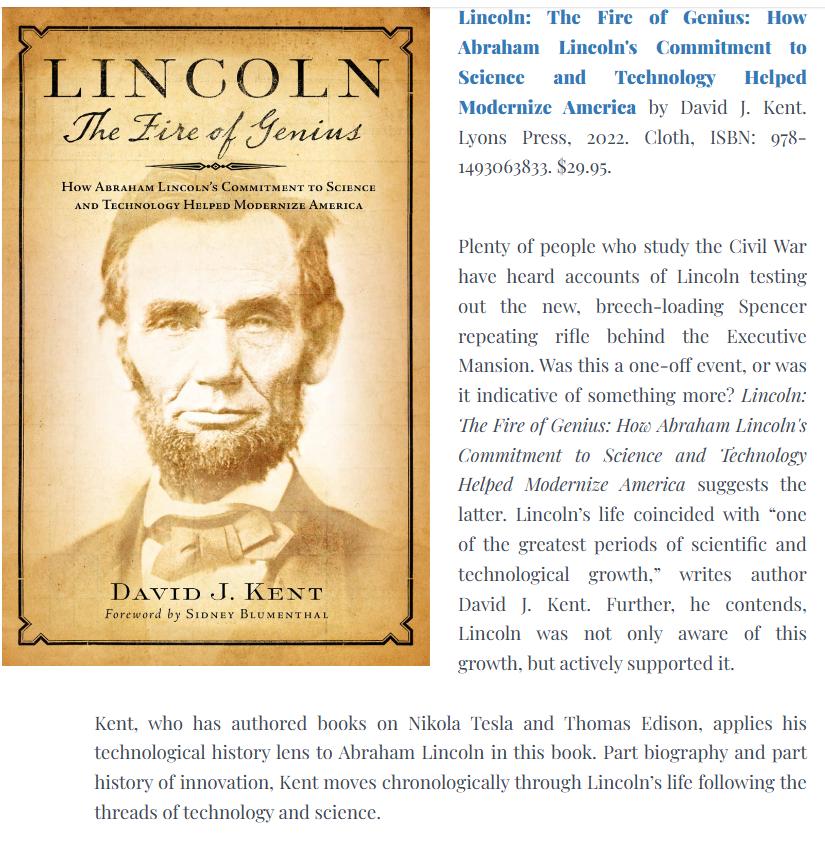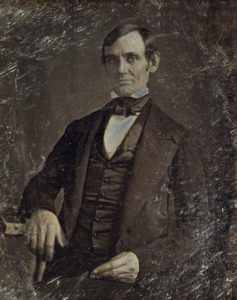 On April 4, 1860, a mere six weeks before he would be nominated as the Republican candidate for president, Abraham Lincoln wins a case formally known as Johnston v. Jones & Marsh.
On April 4, 1860, a mere six weeks before he would be nominated as the Republican candidate for president, Abraham Lincoln wins a case formally known as Johnston v. Jones & Marsh.
Lincoln’s experience getting stuck on the mill dam came in handy when he took on one of his most informative cases, commonly called the Sand Bar Case. The case was revealing because, in an age where trial transcripts were almost never kept, journalist Robert Hitt was paid to sit through the entire trial and create a comprehensive 482-page trial transcript, although he omitted the closing arguments.
The case revolved around the accretion of new land created by various efforts to turn Lake Michigan’s shoreline at Chicago into a practical harbor, something nature had not designed it to do. Channels were dug, piers were built, and a great deal of sand was dredged. Eventually, Chicago had a harbor. In 1833, the government cut a channel across lakefront lots owned separately by William Johnston and William Jones. A newly erected pier caused the accretion of nearly 1,200 feet of new land, roughly six acres, which both Johnston and Jones claimed as their own. After four trials, the last of which found for Johnston, Jones appealed to the Supreme Court, which reversed the judgment and sent it back to the lower courts. At this point, Jones retained Lincoln, and after an eleven-day trial, the jury sided with Jones.
The case highlighted Lincoln’s knowledge of natural environments and his clear, logical communication to jurors. A legal colleague, while not specifically talking about the Sand Bar Case, seemed to capture the flavor of it when he called Lincoln “an admirable tactician” who “steered this jury from the bayous and eddies of side issues and kept them clear of the snags and sand bars, if any were put in the real channel of his case.” Fellow lawyer Leonard Swett also suggested Lincoln had a knack for focusing the juror on the key question while minimizing the rest. “By giving away six points and carrying the seventh, he carried the case.” Lincoln demonstrated this Euclidean logic and technical expertise in a letter to Johnson’s attorney Robert Kinzie before the trial, querying him on such technical matters as the intersection of the pier, the accreted new lakeshore, and the properties in question, as well as the timing of the land formation and any changes since the initial pier was erected. During the trial, Lincoln’s background in surveying helped him cross-examine the surveyor George Snow, catching that there were two maps created, each one alternatively benefiting the claims of the two litigants. Lincoln’s questioning of the land surveys was key to winning the case. He was paid $350 for his services (about $11,600 today).
[Adapted from Lincoln: The Fire of Genius]

Lincoln: The Fire of Genius: How Abraham Lincoln’s Commitment to Science and Technology Helped Modernize America is available at booksellers nationwide.
Limited signed copies are available via this website. The book also listed on Goodreads, the database where I keep track of my reading. Click on the “Want to Read” button to put it on your reading list. Please leave a review on Goodreads and Amazon if you like the book.
You also follow my author page on Facebook.
David J. Kent is President of the Lincoln Group of DC and the author of Lincoln: The Fire of Genius: How Abraham Lincoln’s Commitment to Science and Technology Helped Modernize America and Lincoln: The Man Who Saved America.
His previous books include Tesla: The Wizard of Electricity and Edison: The Inventor of the Modern World and two specialty e-books: Nikola Tesla: Renewable Energy Ahead of Its Time and Abraham Lincoln and Nikola Tesla: Connected by Fate.



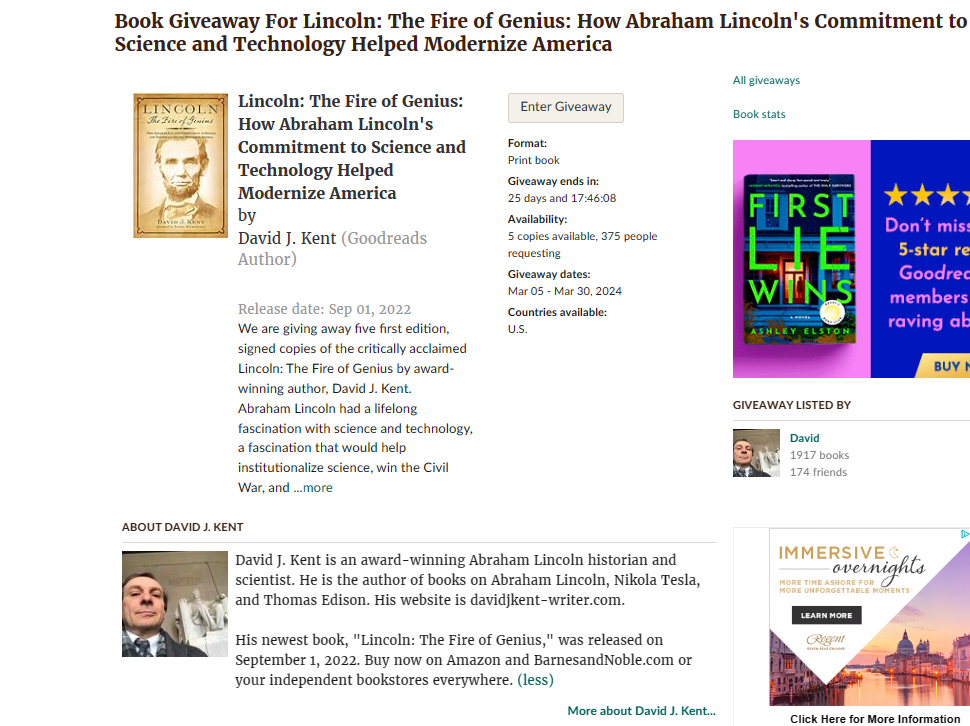
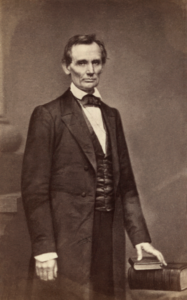 On January 5, 1858, Abraham Lincoln wrote to Robert A. Kinzie of Chicago regarding the case of Johnston v. Jones and Marsh, commonly called the Sand Bar Case. The case was revealing because, in an age where trial transcripts were almost never kept, journalist Robert Hitt was paid to sit through the entire trial and create a comprehensive 482-page trial transcript, although he omitted the closing arguments.
On January 5, 1858, Abraham Lincoln wrote to Robert A. Kinzie of Chicago regarding the case of Johnston v. Jones and Marsh, commonly called the Sand Bar Case. The case was revealing because, in an age where trial transcripts were almost never kept, journalist Robert Hitt was paid to sit through the entire trial and create a comprehensive 482-page trial transcript, although he omitted the closing arguments.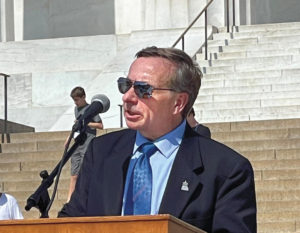 The year in a writer’s life was busy. Some of it actually went according to plan, while some of it was, well, off-plan. I continued to do events related to my book, Lincoln: The Fire of Genius, and continued to write for the Lincoln Group and other venues. On the other hand, some of my writing goals turned out to be unrealistic and have been punted to next year. That said, overall, 2023 was a successful writing year.
The year in a writer’s life was busy. Some of it actually went according to plan, while some of it was, well, off-plan. I continued to do events related to my book, Lincoln: The Fire of Genius, and continued to write for the Lincoln Group and other venues. On the other hand, some of my writing goals turned out to be unrealistic and have been punted to next year. That said, overall, 2023 was a successful writing year.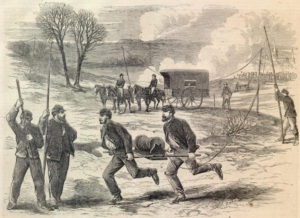 Abraham Lincoln was a big fan of technology and used the telegraph as a war-management tool during the Civil War. The value of the telegraph was reinforced daily. Lincoln received many messages over the new
Abraham Lincoln was a big fan of technology and used the telegraph as a war-management tool during the Civil War. The value of the telegraph was reinforced daily. Lincoln received many messages over the new  On October 4, 1861, Lincoln observed the ascension of a balloon piloted by John LaMountain from General Benjamin Butler’s headquarters at Fort Monroe, Virginia. The balloon passes over Washington and lands 12 miles away in Maryland. While the sanctimonious LaMountain is sometimes accredited with having made the first report of useful intelligence on enemy activity, he was quickly overshadowed by other aeronauts, the Civil War name for balloon pilots.
On October 4, 1861, Lincoln observed the ascension of a balloon piloted by John LaMountain from General Benjamin Butler’s headquarters at Fort Monroe, Virginia. The balloon passes over Washington and lands 12 miles away in Maryland. While the sanctimonious LaMountain is sometimes accredited with having made the first report of useful intelligence on enemy activity, he was quickly overshadowed by other aeronauts, the Civil War name for balloon pilots.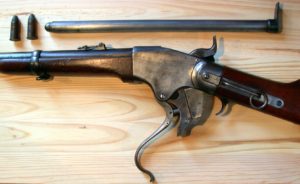 On August 17, 1863, Christopher M. Spencer, inventor of Spencer rifle, presents his new repeating rifle to President Abraham Lincoln and demonstrates how to assemble it. Lincoln was always keen on implementing new military technology during the Civil War, although his generals were not always so eager to follow his lead. Chief of Ordnance James Wolfe Ripley argued that more advanced weaponry was not self-evidently better in the field. Complicated weapons in the hands of untested soldiers and poor weather conditions led to vast inefficiencies in his mind, so Ripley denied the use of some of the new-fangled ideas Lincoln liked.
On August 17, 1863, Christopher M. Spencer, inventor of Spencer rifle, presents his new repeating rifle to President Abraham Lincoln and demonstrates how to assemble it. Lincoln was always keen on implementing new military technology during the Civil War, although his generals were not always so eager to follow his lead. Chief of Ordnance James Wolfe Ripley argued that more advanced weaponry was not self-evidently better in the field. Complicated weapons in the hands of untested soldiers and poor weather conditions led to vast inefficiencies in his mind, so Ripley denied the use of some of the new-fangled ideas Lincoln liked.